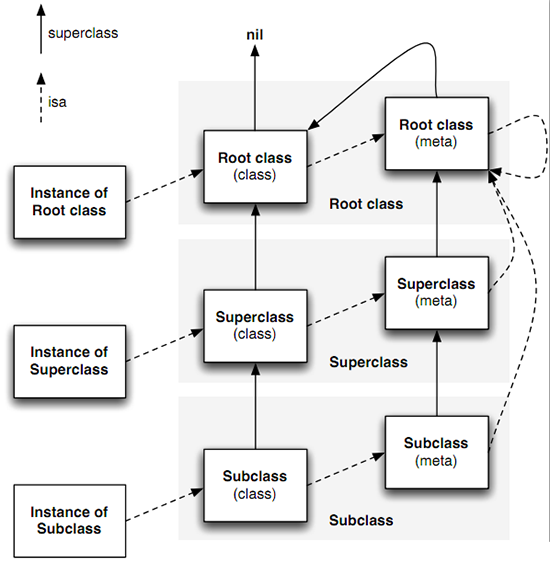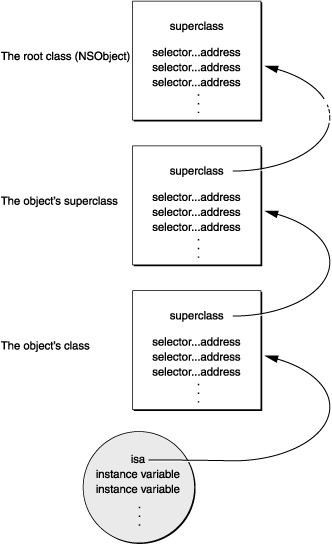Objective-C 是面相运行时的语言(runtime oriented language),就是说它会尽可能的把编译和链接时要执行的逻辑延迟到运行时。这就给了你很大的灵活性,你可以按需要把消息重定向给合适的对象,你甚 至可以交换方法的实现,等等(译注:在 Objective-C 中调用一个对象的方法可以看成向一个对象发送消息, Method Swizzling 具体实现可以参看 jrswizzle )。这就需要使用 runtime。Runtime系统来动态创建类和对象,进行消息发送和转发。
OC 类处理
参考 :
http://blog.csdn.net/lpstudy/article/details/21954711?utm_source=tuicool&utm_medium=referral
runtime是开源的。可以去down:http://opensource.apple.com/tarballs/objc4/objc4-437.1.tar.gz
我们可以Object.h从看对象的定义的实现 其实是一个结构体
/*
Object.h
Copyright 1988-1996 NeXT Software, Inc.
DEFINED AS: A common class
HEADER FILES: <objc/Object.h>
#if __OBJC2__
@interface Object
{
Class isa; /* A pointer to the instance's class structure */
}
+class;
-(BOOL) isEqual:anObject;
@end
#else
@interface Object
{
Class isa; /* A pointer to the instance's class structure */
}
/* Initializing classes and instances */
*/isa 是一个指向实例的类的指针,
然后接下来使一些方法,包括
/* Creating, copying, and freeing instances */
/* Identifying classes */
/* Identifying and comparing instances */
/* Testing inheritance relationships */等还有指向父类的指针
其实Class 中的 *isa 本身就是一个指针类型
在 Objective-C 中的对象的一个重要的特性是,你可以向它们发送消息:当你向一个 Objective-C 的对象发送消息的时候,runtime 沿着对象的 isa 指针找到了这个对象的 Class结构体。 Class 结构体中包含了一个这个类的方法列表和一个指向父类的指针,用于查找继承的方法。
Class本身就是一个指针类型,是一个指向objc_class结构体指针。
lobjc_class是什么?就是类的定义
typedef struct objc_class *Class;
struct objc_class
{
struct objc_class* isa;
struct objc_class*super_class;
const char*name;
long version;
long info;
long instance_size;
struct objc_ivar_list* ivars;
struct objc_method_list** methodLists;
struct objc_cache* cache;
struct objc_protocol_list* protocols;
};同样的, struct objc_class 中让我们在 Class 上调用一个方法,Class 的 isa 指针必须指向一个 Class 结构体,并且那个 Class 结构体必须包含我们可以在那个 Class 上调用的方法的列表
这就引出了 meta-class 的定义:meta-class 是 Class 对象的类(the meta-class is the class for a Class object)。
cache用来缓存经常访问的方法,它指向objc_cache结构体,后面会重点讲到。
protocols表示类遵循哪些协议。
ivars表示多个成员变量,它指向objc_ivar_list结构体。在runtime.h可以看到它的定义
struct objc_ivar_list {
int ivar_count OBJC2_UNAVAILABLE;
#ifdef __LP64__
int space OBJC2_UNAVAILABLE;
#endif
/* variable length structure */
struct objc_ivar ivar_list[1] OBJC2_UNAVAILABLE;
}methodLists表示方法列表,它指向objc_method_list结构体的二级指针,可以动态修改*methodLists的值来添加成员方法,也是Category实现原理,同样也解释Category不能添加属性的原因。在runtime.h可以看到它的定义:
struct objc_method_list {
struct objc_method_list *obsolete OBJC2_UNAVAILABLE;
int method_count OBJC2_UNAVAILABLE;
#ifdef __LP64__
int space OBJC2_UNAVAILABLE;
#endif
/* variable length structure */
struct objc_method method_list[1] OBJC2_UNAVAILABLE;
}同理,objc_method_list也是一个链表,存储多个objc_method,而objc_method结构体存储类的某个方法的信息。
Ivar
Ivar其实就是一个指向objc_ivar结构体指针,它包含了变量名(ivar_name)、变量类型(ivar_type)等信息。
Ivar表示类中的实例变量,在runtime.h文件中找到它的定义:
/// An opaque type that represents an instance variable.
typedef struct objc_ivar *Ivar;
struct objc_ivar {
char *ivar_name OBJC2_UNAVAILABLE;
char *ivar_type OBJC2_UNAVAILABLE;
int ivar_offset OBJC2_UNAVAILABLE;
#ifdef __LP64__
int space OBJC2_UNAVAILABLE;
#endif
}Cache
顾名思义,Cache主要用来缓存,那它缓存什么呢?我们先在runtime.h文件看看它的定义:
typedef struct objc_cache *Cache OBJC2_UNAVAILABLE;
struct objc_cache {
unsigned int mask /* total = mask + 1 */ OBJC2_UNAVAILABLE;
unsigned int occupied OBJC2_UNAVAILABLE;
Method buckets[1] OBJC2_UNAVAILABLE;
};ache其实就是一个存储Method的链表,主要是为了优化方法调用的性能。当对象receiver调用方法message时,首先根据对象receiver的isa指针查找到它对应的类,然后在类的methodLists中搜索方法,如果没有找到,就使用super_class指针到父类中的methodLists查找,一旦找到就调用方法。如果没有找到,有可能消息转发,也可能忽略它。但这样查找方式效率太低,因为往往一个类大概只有20%的方法经常被调用,占总调用次数的80%。所以使用Cache来缓存经常调用的方法,当调用方法时,优先在Cache查找,如果没有找到,再到methodLists查找。

meta-class 是 Class 对象的类。每个 Class 都有个不同的自己的 meta-class(因此每个 Class 都可以有一个自己不同的方法列表)。也就是说每个类的 Class 不完全相同。
meta-class 总是会保证 Class 对象会有从基类继承的所有的的实例和类方法,加上之后继承的类方法。如从 NSObject 继承的类,就意味着在所有的 Class(和 meta-class)对象中定义了所有从 NSObject 继承的实例和协议方法。
所有的 meta-class 使用基类的 meta-class(NSObject 的 meta-class 用于继承自 NSObject 的类)作为他们自己的类,包括在运行时自己定义的基础的 meta-class。
简单来说:
- 当你向一个对象发送消息,就在那个对象的方法列表中查找那个消息( 就是 -(typename) methodname 。。。 声明的实力方法
- 当你想一个类发送消息,就再那个类的 meta-class 中查找那个消息。( + (typename) methodname 。。。声明的类方法。
- 并且meta-class 是必须的,因为它为一个 Class 存储类方法。每个类都必须有一个唯一的 meta-class,因为每个 Class 都有一个可能不一样的类方法。
和 Class 以 super_class 指针指向它的父类的方法一样,meta-class 以 super_class 指针指向 Class 的 super_class 的 meta-class。(译注:这句话有点绕,就是 super-class 一个指向 Class 的父类,一个指向 meta-class 的父类。Class 是一般对象的类型,meta-class 是 Class 的类型。)
消息机制
参考:
http://www.cocoachina.com/bbs/read.php?tid=189505
在runtime中Message也是一个结构体
struct objc_method {
SEL method_name OBJC2 _UNAVAILABLE;
char *method_types OBJC2_UNAVAILABLE;
IMP method_imp OBJC2_UNAVAILABLE;
}
/*OBJC2_UNAVAILABLE是一个Apple对Objc系统运行版本进行约束的宏定义,主要为了兼容非Objective-C 2.0的遗留版本,但我们仍能从中获取一些有用信息。 */ IMP
在上面讲Method时就说过,IMP本质上就是一个函数指针,指向方法的实现,在objc.h找到它的定义:
/// A pointer to the function of a method implementation.
#if !OBJC_OLD_DISPATCH_PROTOTYPES
typedef void (*IMP)(void /* id, SEL, ... */ );
#else
typedef id (*IMP)(id, SEL, ...);
#endifid objc_msgSend ( id self, SEL op, ... ); 首先 SEL 类里面的方法都是被转换成SEL变量进行存储的。SEL其本身是一个Int类型的一个地址,地址中存放着方法的名字。对于一个类中。每一个方法对应着一个SEL。所以iOS类中不能存在2个名称相同 的方法,即使参数类型不同,因为SEL是根据方法名字生成的,相同的方法名称只能对应一个SEL。SEL 可以用@selector()取类方法的编号,他的行为基本可以等同C语言的中函数指针,只不过C语言中,可以把函数名直接赋给一个函数指针,而Object-C的类不能直接应用函数指针,这样只能做一个@selector语法来取.
id其实就是一个指向objc_object结构体指针,它包含一个Class isa成员,根据isa指针就可以顺藤摸瓜找到对象所属的类。
/// Represents an instance of a class.
struct objc_object {
Class isa OBJC_ISA_AVAILABILITY;
};
/// A pointer to an instance of a class.
typedef struct objc_object *id;C/C++ 函数指针
#include <iostream>
#include <stdio.h>
#include <string.h>
#include <algorithm>
using namespace std;
int (* funcp)(int, int);
int func(int a, int b)
{
return a + b;
}
int main()
{
funcp = &func;
cout<<funcp(1, 2)<<endl;
return 0;
}
object-c的选择器
SEL afun = @selector(someMethodName:::::);在让我们看一下objc_msgSend它具体是如何发送消息:
首先根据receiver对象的isa指针获取它对应的class;
优先在class的cache查找message方法,如果找不到,再到methodLists查找;
如果没有在class找到,再到super_class查找;
一旦找到message这个方法,就执行它实现的IMP。
消息转发机制
receiver message]调用方法时,如果在message方法在receiver对象的类继承体系中没有找到方法,那怎么办?一般情况下,程序在运行时就会Crash掉,抛出unrecognized selector sent to…类似这样的异常信息。但在抛出异常之前,还有三次机会按以下顺序让你拯救程序。

Method Resolution
首先Objective-C在运行时调用+ resolveInstanceMethod:或+ resolveClassMethod:方法,让你添加方法的实现。如果你添加方法并返回YES,那系统在运行时就会重新启动一次消息发送的过程。
举一个简单例子,定义一个类Message,它主要定义一个方法sendMessage,下面就是它的设计与实现:
@interface Message : NSObject
- (void)sendMessage:(NSString *)word;
@end
[cpp] view plaincopy
@implementation Message
- (void)sendMessage:(NSString *)word
{
NSLog(@"normal way : send message = %@", word);
}
@end 如果我在viewDidLoad方法中创建Message对象并调用sendMessage方法:
- (void)viewDidLoad {
[super viewDidLoad];
Message *message = [Message new];
[message sendMessage:@"Sam Lau"];
} 控制台会打印以下信息:
normal way : send message = Sam Lau
但现在我将原来sendMessage方法实现给注释掉,覆盖resolveInstanceMethod方法:
#pragma mark - Method Resolution
/// override resolveInstanceMethod or resolveClassMethod for changing sendMessage method implementation
+ (BOOL)resolveInstanceMethod:(SEL)sel
{
if (sel == @selector(sendMessage:)) {
class_addMethod([self class], sel, imp_implementationWithBlock(^(id self, NSString *word) {
NSLog(@"method resolution way : send message = %@", word);
}), "v@*");
}
return YES;
} 控制台就会打印以下信息:
method resolution way : send message = Sam Lau
注意到上面代码有这样一个字符串”v@*,它表示方法的参数和返回值,详情请参考Type Encodings。
如果resolveInstanceMethod方法返回NO,运行时就跳转到下一步:消息转发(Message Forwarding)。
Fast Forwarding
如果目标对象实现- forwardingTargetForSelector:方法,系统就会在运行时调用这个方法,只要这个方法返回的不是nil或self,也会重启消息发送的过程,把这消息转发给其他对象来处理。否则,就会继续Normal Fowarding。
继续上面Message类的例子,将sendMessage和resolveInstanceMethod方法注释掉,然后添加forwardingTargetForSelector方法的实现:
#pragma mark - Fast Forwarding
- (id)forwardingTargetForSelector:(SEL)aSelector
{
if (aSelector == @selector(sendMessage:)) {
return [MessageForwarding new];
}
return nil;
} 此时还缺一个转发消息的类MessageForwarding,这个类的设计与实现如下:
@interface MessageForwarding : NSObject
- (void)sendMessage:(NSString *)word;
@end
[cpp] view plaincopy
@implementation MessageForwarding
- (void)sendMessage:(NSString *)word
{
NSLog(@"fast forwarding way : send message = %@", word);
}
@end 此时,控制台会打印以下信息:
fast forwarding way : send message = Sam Lau
这里叫Fast,是因为这一步不会创建NSInvocation对象,但Normal Forwarding会创建它,所以相对于更快点。
Normal Forwarding
如果没有使用Fast Forwarding来消息转发,最后只有使用Normal Forwarding来进行消息转发。它首先调用methodSignatureForSelector:方法来获取函数的参数和返回值,如果返回为nil,程序会Crash掉,并抛出unrecognized selector sent to instance异常信息。如果返回一个函数签名,系统就会创建一个NSInvocation对象并调用-forwardInvocation:方法。
继续前面的例子,将forwardingTargetForSelector方法注释掉,添加methodSignatureForSelector和forwardInvocation方法的实现:
#pragma mark - Normal Forwarding
- (NSMethodSignature *)methodSignatureForSelector:(SEL)aSelector
{
NSMethodSignature *methodSignature = [super methodSignatureForSelector:aSelector];
if (!methodSignature) {
methodSignature = [NSMethodSignature signatureWithObjCTypes:"v@:*"];
}
return methodSignature;
}
- (void)forwardInvocation:(NSInvocation *)anInvocation
{
MessageForwarding *messageForwarding = [MessageForwarding new];
if ([messageForwarding respondsToSelector:anInvocation.selector]) {
[anInvocation invokeWithTarget:messageForwarding];
}
} 三种方法的选择
Runtime提供三种方式来将原来的方法实现代替掉,那该怎样选择它们呢?
Method Resolution:由于Method Resolution不能像消息转发那样可以交给其他对象来处理,所以只适用于在原来的类中代替掉。
Fast Forwarding:它可以将消息处理转发给其他对象,使用范围更广,不只是限于原来的对象。
Normal Forwarding:它跟Fast Forwarding一样可以消息转发,但它能通过NSInvocation对象获取更多消息发送的信息,例如:target、selector、arguments和返回值等信息。
Associated Objects
当使用Category对某个类进行扩展时,有时需要存储属性,Category是不支持的,这时需要使用Associated Objects来给已存在的类Category添加自定义的属性。Associated Objects提供三个API来向对象添加、获取和删除关联值:
void objc_setAssociatedObject (id object, const void *key, id value, objc_AssociationPolicy policy )
id objc_getAssociatedObject (id object, const void *key )
void objc_removeAssociatedObjects (id object )其中objc_AssociationPolicy是个枚举类型,它可以指定Objc内存管理的引用计数机制。
typedef OBJC_ENUM(uintptr_t, objc_AssociationPolicy) {
OBJC_ASSOCIATION_ASSIGN = 0, /**< Specifies a weak reference to the associated object. */
OBJC_ASSOCIATION_RETAIN_NONATOMIC = 1, /**< Specifies a strong reference to the associated object.
* The association is not made atomically. */
OBJC_ASSOCIATION_COPY_NONATOMIC = 3, /**< Specifies that the associated object is copied.
* The association is not made atomically. */
OBJC_ASSOCIATION_RETAIN = 01401, /**< Specifies a strong reference to the associated object.
* The association is made atomically. */
OBJC_ASSOCIATION_COPY = 01403 /**< Specifies that the associated object is copied.
* The association is made atomically. */
}; 个关于NSObject+AssociatedObject Category添加属性associatedObject的示例代码:
NSObject+AssociatedObject@interface NSObject (AssociatedObject)
@property (strong, nonatomic) id associatedObject;
@end
NSObject+AssociatedObject.m
@implementation NSObject (AssociatedObject)
- (void)setAssociatedObject:(id)associatedObject
{
objc_setAssociatedObject(self, @selector(associatedObject), associatedObject, OBJC_ASSOCIATION_RETAIN_NONATOMIC);
}
- (id)associatedObject
{
return objc_getAssociatedObject(self, _cmd);
}
@end Associated Objects的key要求是唯一并且是常量,而SEL是满足这个要求的,所以上面的采用隐藏参数_cmd作为key。























 250
250











 被折叠的 条评论
为什么被折叠?
被折叠的 条评论
为什么被折叠?








